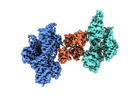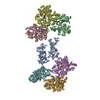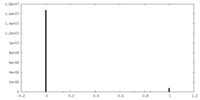[English] 日本語
 Yorodumi
Yorodumi- EMDB-43764: cryo-EM structure of fascin crosslinked F-actin (containing both ... -
+ Open data
Open data
- Basic information
Basic information
| Entry |  | |||||||||
|---|---|---|---|---|---|---|---|---|---|---|
| Title | cryo-EM structure of fascin crosslinked F-actin (containing both actin binding sites) | |||||||||
 Map data Map data | refined consensus map | |||||||||
 Sample Sample |
| |||||||||
 Keywords Keywords | Cytoskeleton / F-actin crosslinker / F-actin bundle / STRUCTURAL PROTEIN | |||||||||
| Biological species |  Homo sapiens (human) Homo sapiens (human) | |||||||||
| Method | single particle reconstruction / cryo EM / Resolution: 3.39 Å | |||||||||
 Authors Authors | Gong R / Reynolds MJ / Alushin GM | |||||||||
| Funding support |  United States, 2 items United States, 2 items
| |||||||||
 Citation Citation |  Journal: Nat Struct Mol Biol / Year: 2025 Journal: Nat Struct Mol Biol / Year: 2025Title: Fascin structural plasticity mediates flexible actin bundle construction. Authors: Rui Gong / Matthew J Reynolds / Keith R Carney / Keith Hamilton / Tamara C Bidone / Gregory M Alushin /  Abstract: Fascin cross-links actin filaments (F-actin) into bundles that support tubular membrane protrusions including filopodia and stereocilia. Fascin dysregulation drives aberrant cell migration during ...Fascin cross-links actin filaments (F-actin) into bundles that support tubular membrane protrusions including filopodia and stereocilia. Fascin dysregulation drives aberrant cell migration during metastasis, and fascin inhibitors are under development as cancer therapeutics. Here, we use cryo-EM, cryo-electron tomography coupled with custom denoising and computational modeling to probe human fascin-1's F-actin cross-linking mechanisms across spatial scales. Our fascin cross-bridge structure reveals an asymmetric F-actin binding conformation that is allosterically blocked by the inhibitor G2. Reconstructions of seven-filament hexagonal bundle elements, variability analysis and simulations show how structural plasticity enables fascin to bridge varied interfilament orientations, accommodating mismatches between F-actin's helical symmetry and bundle hexagonal packing. Tomography of many-filament bundles and modeling uncover geometric rules underlying emergent fascin binding patterns, as well as the accumulation of unfavorable cross-links that limit bundle size. Collectively, this work shows how fascin harnesses fine-tuned nanoscale structural dynamics to build and regulate micron-scale F-actin bundles. | |||||||||
| History |
|
- Structure visualization
Structure visualization
| Supplemental images |
|---|
- Downloads & links
Downloads & links
-EMDB archive
| Map data |  emd_43764.map.gz emd_43764.map.gz | 273.1 MB |  EMDB map data format EMDB map data format | |
|---|---|---|---|---|
| Header (meta data) |  emd-43764-v30.xml emd-43764-v30.xml emd-43764.xml emd-43764.xml | 13.8 KB 13.8 KB | Display Display |  EMDB header EMDB header |
| FSC (resolution estimation) |  emd_43764_fsc.xml emd_43764_fsc.xml | 15.8 KB | Display |  FSC data file FSC data file |
| Images |  emd_43764.png emd_43764.png | 81.9 KB | ||
| Masks |  emd_43764_msk_1.map emd_43764_msk_1.map | 343 MB |  Mask map Mask map | |
| Filedesc metadata |  emd-43764.cif.gz emd-43764.cif.gz | 4 KB | ||
| Others |  emd_43764_half_map_1.map.gz emd_43764_half_map_1.map.gz emd_43764_half_map_2.map.gz emd_43764_half_map_2.map.gz | 273.9 MB 273.9 MB | ||
| Archive directory |  http://ftp.pdbj.org/pub/emdb/structures/EMD-43764 http://ftp.pdbj.org/pub/emdb/structures/EMD-43764 ftp://ftp.pdbj.org/pub/emdb/structures/EMD-43764 ftp://ftp.pdbj.org/pub/emdb/structures/EMD-43764 | HTTPS FTP |
-Validation report
| Summary document |  emd_43764_validation.pdf.gz emd_43764_validation.pdf.gz | 1 MB | Display |  EMDB validaton report EMDB validaton report |
|---|---|---|---|---|
| Full document |  emd_43764_full_validation.pdf.gz emd_43764_full_validation.pdf.gz | 1 MB | Display | |
| Data in XML |  emd_43764_validation.xml.gz emd_43764_validation.xml.gz | 23.5 KB | Display | |
| Data in CIF |  emd_43764_validation.cif.gz emd_43764_validation.cif.gz | 31.2 KB | Display | |
| Arichive directory |  https://ftp.pdbj.org/pub/emdb/validation_reports/EMD-43764 https://ftp.pdbj.org/pub/emdb/validation_reports/EMD-43764 ftp://ftp.pdbj.org/pub/emdb/validation_reports/EMD-43764 ftp://ftp.pdbj.org/pub/emdb/validation_reports/EMD-43764 | HTTPS FTP |
-Related structure data
- Links
Links
| EMDB pages |  EMDB (EBI/PDBe) / EMDB (EBI/PDBe) /  EMDataResource EMDataResource |
|---|
- Map
Map
| File |  Download / File: emd_43764.map.gz / Format: CCP4 / Size: 343 MB / Type: IMAGE STORED AS FLOATING POINT NUMBER (4 BYTES) Download / File: emd_43764.map.gz / Format: CCP4 / Size: 343 MB / Type: IMAGE STORED AS FLOATING POINT NUMBER (4 BYTES) | ||||||||||||||||||||||||||||||||||||
|---|---|---|---|---|---|---|---|---|---|---|---|---|---|---|---|---|---|---|---|---|---|---|---|---|---|---|---|---|---|---|---|---|---|---|---|---|---|
| Annotation | refined consensus map | ||||||||||||||||||||||||||||||||||||
| Projections & slices | Image control
Images are generated by Spider. | ||||||||||||||||||||||||||||||||||||
| Voxel size | X=Y=Z: 1.03 Å | ||||||||||||||||||||||||||||||||||||
| Density |
| ||||||||||||||||||||||||||||||||||||
| Symmetry | Space group: 1 | ||||||||||||||||||||||||||||||||||||
| Details | EMDB XML:
|
-Supplemental data
-Mask #1
| File |  emd_43764_msk_1.map emd_43764_msk_1.map | ||||||||||||
|---|---|---|---|---|---|---|---|---|---|---|---|---|---|
| Projections & Slices |
| ||||||||||||
| Density Histograms |
-Half map: Half map 1
| File | emd_43764_half_map_1.map | ||||||||||||
|---|---|---|---|---|---|---|---|---|---|---|---|---|---|
| Annotation | Half map 1 | ||||||||||||
| Projections & Slices |
| ||||||||||||
| Density Histograms |
-Half map: Half map 2
| File | emd_43764_half_map_2.map | ||||||||||||
|---|---|---|---|---|---|---|---|---|---|---|---|---|---|
| Annotation | Half map 2 | ||||||||||||
| Projections & Slices |
| ||||||||||||
| Density Histograms |
- Sample components
Sample components
-Entire : Fascin crosslinked F-actin (containing both actin binding sites)
| Entire | Name: Fascin crosslinked F-actin (containing both actin binding sites) |
|---|---|
| Components |
|
-Supramolecule #1: Fascin crosslinked F-actin (containing both actin binding sites)
| Supramolecule | Name: Fascin crosslinked F-actin (containing both actin binding sites) type: complex / ID: 1 / Parent: 0 / Macromolecule list: #1-#2 |
|---|---|
| Source (natural) | Organism:  Homo sapiens (human) Homo sapiens (human) |
| Molecular weight | Theoretical: 5.4 kDa/nm |
-Experimental details
-Structure determination
| Method | cryo EM |
|---|---|
 Processing Processing | single particle reconstruction |
| Aggregation state | filament |
- Sample preparation
Sample preparation
| Buffer | pH: 8 |
|---|---|
| Vitrification | Cryogen name: ETHANE |
- Electron microscopy
Electron microscopy
| Microscope | FEI TITAN KRIOS |
|---|---|
| Image recording | Film or detector model: GATAN K2 SUMMIT (4k x 4k) / Average electron dose: 61.26 e/Å2 |
| Electron beam | Acceleration voltage: 300 kV / Electron source:  FIELD EMISSION GUN FIELD EMISSION GUN |
| Electron optics | Illumination mode: FLOOD BEAM / Imaging mode: BRIGHT FIELD / Nominal defocus max: 2.8000000000000003 µm / Nominal defocus min: 0.8 µm |
| Experimental equipment |  Model: Titan Krios / Image courtesy: FEI Company |
 Movie
Movie Controller
Controller


















 Z (Sec.)
Z (Sec.) Y (Row.)
Y (Row.) X (Col.)
X (Col.)














































